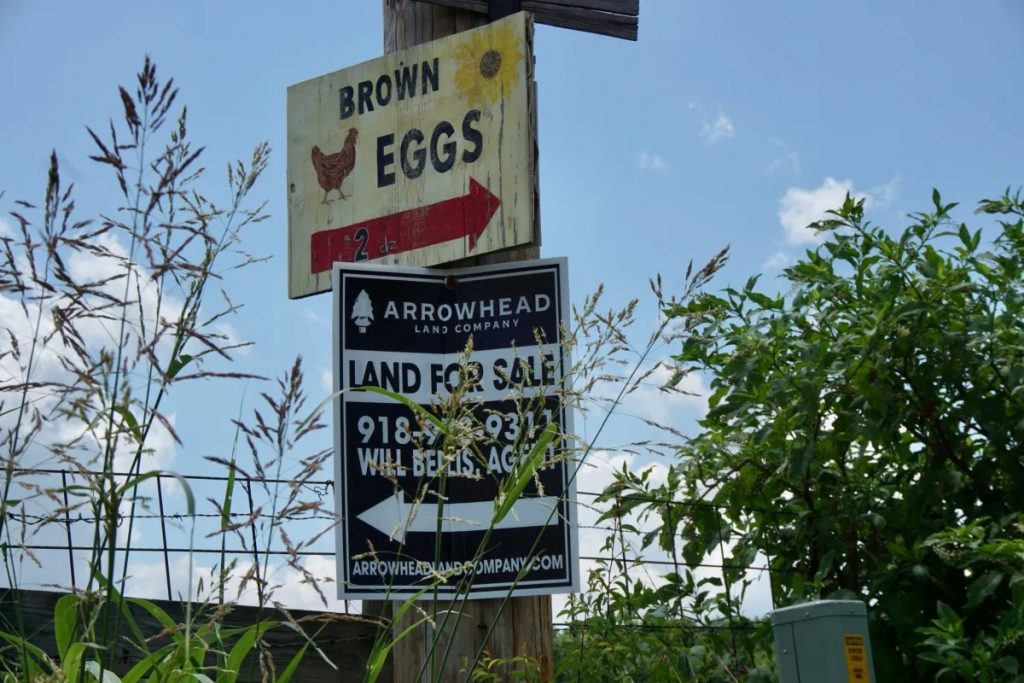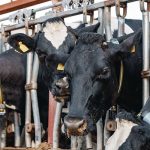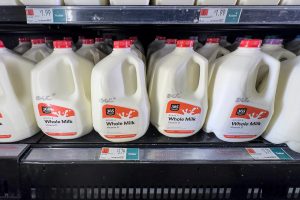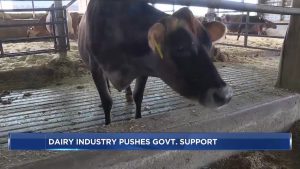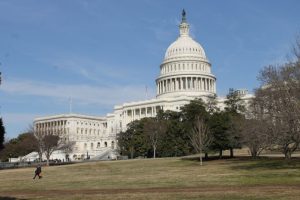
America is losing farmers. This is the role land values play.
Key takeaways
* An Investigate Midwest analysis shows the areas with the largest increases in farmland prices have lost the most farmers.
* Large investment firms are driving up farmland prices. In many cases, farmland is sold at prices multiple times the regional average.
* The cost increases have hit young and beginning farmers the hardest.
As Jess Bray pulled up to a 21-acre farm nestled in an eastern Oklahoma valley, she instantly got a warm feeling. “This is the place,” she thought.
After attempting to buy two other properties before being outbid by cash buyers, Bray and her husband Jon began to wonder whether their dream of owning and operating their own farm would become a reality.
“We always wanted to farm, but we aren’t trust fund kids, we didn’t grow up in agriculture … we didn’t have a farm handed down to us, so it wasn’t something that was very accessible to us,” Bray said. “This was a dream come true … but it wasn’t without challenges.”
In 2022, Bray, then 39, purchased the valley property, which they now operate under the name Blue Mountain Farm, growing a variety of vegetables, and raising pigs and a dairy cow near the town of McCurtin.
While Bray eventually realized her dream, the rising cost of farmland has priced out many other would-be farmers and ranchers or forced others into early retirement. The parts of the country where farmland prices have seen the largest increase have also been where the number of agriculture producers has declined the most.

From 2017 to 2022, the average value per acre of all American farmland grew from $4,368 to $5,354, an increase of nearly 23%, according to USDA data on the market value of farmland and its buildings.
But in the 409 counties across the country that saw a producer decline of 15% or greater over the past five years, average farmland values increased by 31%, according to Investigate Midwest’s analysis of USDA reports, land value records and other property data.
In reviewing property records and speaking with more than a dozen officials who closely track farmland values, Investigate Midwest found there are multiple causes for the decline in producers in counties that saw the most significant increase in value:
- Population growth expanding into rural communities has increased prices and reduced farmland as 11 million acres of agricultural land were converted into residential properties from 2001 to 2016, according to the American Farmland Trust.
- The push towards wind and solar energy, often backed by government subsidies, has also raised land rents much higher than for traditional agricultural use.
- Large investment firms, such as Farmland Partners, PGIM and Gladstone Land, are paying top dollar for land and reselling some property at amounts as much as five times higher than the regional average.
- The move towards industrial farms has also meant more corporate land buyers who can pay cash and beat many local offers.
“The biggest competition (for farmland) used to be from the person who wanted a hobby farm but maybe wasn’t farming full time,” said Vanessa Garcia Polanco, a policy campaign director with the National Young Farmers Coalition. “Today, the biggest threat we see is from corporations and hedge funds.”
The increase in competition for farmland has been especially detrimental for young and would-be farmers. According to a 2022 National Young Farmers Coalition survey, 59% of farmers under 40 said finding affordable land was “very or extremely challenging.”
Farmland ownership has received increased attention from lawmakers in recent years, especially concerning foreign-owned companies. Lawmakers in dozens of states have pushed laws limiting foreign land ownership, including from countries like Iran and China, often claiming these buyers drive up costs that push out family farms.
However, U.S. Agriculture Secretary Tom Vilsack recently called that focus misguided and said the growth in American investment firms buying farmland is a more pressing concern.
“Do you know roughly a third of all the farming operations that generate more than $500,000 in sales are owned by investment outfits? Are you concerned about Wall Street owning farmland?” Vilsack said in response to a question about foreign-owned land while speaking at the North American Agricultural Journalists conference in April.

But Paul Pittman, the executive chairman of the investment firm Farmland Partners, said companies like his were not to blame for rising prices and were keeping many farms in production.
“That’s populist B.S. and nothing less,” Pittman told Investigate Midwest when asked about Vilsack’s comments. “And remember, for every farmer who is whining about being outbid, there’s a farm family that owned that farm for 100 years and deserves to get the highest price possible.”
Investment firms significantly increase farmland holdings
In the spring of 2023, the Farmland Partners investment firm spent $8.85 million in cash on 1,840 acres of farmland in Haskell County, Oklahoma. The land was a highly productive swath of soybean, corn and wheat fields with an irrigation system pulling water from the nearby Canadian River.
The Denver-based firm had grown in recent years to become the nation’s largest farmland investor, with a valuation of more than half a billion dollars and a portfolio of more than 180,000 acres across the country.
One of the firm’s land buys in Oklahoma was a 174-acre property for $3 million. At $17,232 an acre, the Oklahoma purchase was five times more than the median for comp sales in the area, based on data from the land value tracking site AcreValue.
However, the firm had shown that its high purchase prices were likely to pay off. It had recently sold nearly 2,500 acres of farmland in central Nebraska and South Carolina for a combined $16.2 million, a transaction that netted Farmland Partners a 24% return on investment, the company announced.
According to data from the National Council of Real Estate Investment Fiduciaries, investment firms increased their farmland holdings by 231% from 2008 to 2023. While traditional real estate property is constantly expanding, many investors see the decrease in available farmland as a partial driver of its value.
Most farmland investment firms lease the land back to producers who operate the entire farming business. In a recent SEC filing, Gladstone Land, which owns 111,836 acres of farmland across 15 states, said it rents most of its land to farmers on a “triple-net basis,” which means the tenant pays the related taxes, insurance costs, maintenance, and other operating costs in addition to rent.
However, Pittman, the chairman of Farmland Partners’ board of directors, said there are signs that more farmers are struggling to afford rents.
“There’s a little more trouble out there than there was 12 months ago … and we’re seeing it in having an occasional farmer come to us and say, ‘Hey, can you re-rent this farm to someone else?’ ”Pittman said on a May 1 investor call, according to a transcript. “When we’ve had that occur, we’ve been able to (re-rent) the farms at the same price or in some cases, a little bit higher.”
Asked about Vilsack’s comments, Pittman said declining commodity prices are pinching some farmers.
“Starting in about 2019, commodity prices started to go up pretty fast, but here we are in 2024, and commodity prices have pulled back,” Pittman told Investigate Midwest. “This is a low margin business … so when you see a little bit of a drop in commodity price, it can challenge (a farmer) financially.”
However, Pittman said his firm’s investments remain solid because, in the agriculture sector, “bankruptcies are minuscule.” The 2022 farm bankruptcy rate was 0.84 per 10,000 farms, its lowest rate in nearly 20 years.
A sign for Blue Mountain Farm’s general store on June 17, 2024. photo by Ben Felder, Investigate Midwest
While most farmland is rented to producers, there are times when an alternative use can fetch even more money. Wind farms can attract lucrative rents and often allow the land to remain agricultural. However, the growth in solar farms, which also attract high rental rates, usually means the land can no longer be used to grow crops or raise livestock because of the large solar panels near the ground.
“In Illinois, for example, a farm that may rent for $400 to $500 an acre a year for agriculture, rents for $1,250 to $1,500 a year for solar, and the farmer cannot compete with that,” Pittman said. “To be honest, (when I’m wearing) my fiduciary obligation to my investor’s hat, if somebody offers us $1,500 an acre, it’s going to go to solar. But wearing my Paul the citizen hat, I’m not sure that’s a great thing.”
Industrial farm growth led to a ‘hollowing out of the middle’
In most counties that lost producers, agriculture production actually increased as the remaining farms often grew larger or were converted to industrial operations.
Wisconsin’s Douglas County, located in the state’s northwest corner, lost 31% of its producers from 2017 to 2022 but saw net cash farm incomes more than double and sales from agriculture products increase by 45% during that same period.
Jess Bray reaches out to one of the roosters on her Oklahoma farm on June 17, 2024. photo by Ben Felder, Investigate Midwest
Across the state, five counties saw a producer decline of at least 15% yet also saw agriculture production sales increase.
“Many operators continued to exit, and this happened rapidly among Wisconsin dairy farms,” said Jeff Hadachek, an agriculture professor at the University of Wisconsin. “At the same time, the farms that remained were increasing in size.”
Hadachek said the increase in farm production means the local economy may still be growing even with a loss of producers.
“I think economists would typically say that just looking at the number of farms is not the best way to consider economic health in a community,” Hadachek said. “Certainly, for the people who own land, the increase in value is a great thing … so there are two sides of the issue for sure.”
Like most types of farming, Wisconsin’s dairy industry has seen a move towards more industrial operations to improve efficiency, which can increase profits in a sector with tight margins for smaller dairy farmers.
In 1997, the average Wisconsin dairy farm had 55.6 cows, while the 2022 average topped 203 per farm, according to research from the University of Wisconsin.
Some farmland investors see profit opportunities in the transition to larger farms and are predicting a continued shift toward industrial agriculture.
“An aging farmer generation, fractional family ownership structure and technological advances requiring sizable capital investment will naturally transition farmland holdings from individuals to institutions,” stated a report from PGIM, the $10 billion property asset management company run by Prudential Financial that has increased its farmland holdings in recent years.
Hadachek said the growth in larger operations has led to a decrease in medium-sized farms, what he calls a “hollowing out of the middle.”
“The growth in the larger end reflects consolidation and the economies of scale and size associated with large farms, while the growth in the smaller end reflects growth in specialty foods, farms targeting the ‘local foods’ market, and hobby farming,” Hadachek said.
But Pittman, the executive chairman of the investment firm Farmland Partners, said data on the decline in the number of farms across the country can be deceiving.
A rooster runs across a field at Blue Mountain Farm near McCurtin, Oklahoma on June 17, 2024. photo by Ben Felder, Investigate Midwest
From 2017 to 2022, America lost 141,733 farms, but 80% of those lost farms had less than $2,500 in annual sales.
“You and I know those aren’t really farms, I don’t know why they’re called farms,” Pittman said. “If you’re talking about supporting a family or two families on a farm, you are talking about at least a million dollars in annual sales, which would give you about $50,000 in distributable household income to send your kids to school and pay for food and all that.”
USDA data shows the nation lost 10,537 farms with annual sales of $100,000 to $499,999, but farms making more than $500,000 grew by more than 26,000.
Some states, nonprofits work to protect farmland from development
Construction sounds have become a constant echo in McCurtin County, Oklahoma, where cabins and resorts are being built in the pastures and forests between the Ouachita Mountains and Red River. Tourism growth, especially visitors from the Dallas metro, which is within a two-hour drive, has increased local farmland prices much faster than the state average.
From 2017 to 2022, McCurtin County lost nearly one out of every five producers while the average value per acre soared from $1,901 to $2,601 as investors, second-home buyers, and some private equity firms snatched up land to build vacation homes or sit on the land while its value grew.
“When someone’s waving that kind of money at grandpa’s farm, they let ’em have it,” said Brent Bolin, a poultry producer in McCurtin County, who is also a state agriculture commissioner.
Jess Bray pets two male pigs at Blue Mountain Farm near McCurtin, Oklahoma on June 17, 2024. photo by Ben Felder, Investigate Midwest
In a recent report titled “Farms Under Threat,” the American Farmland Trust found that between 2001 and 2016, more than 11 million acres of farmland was converted to urban and residential use, with Texas, California, Arizona, and Georgia topping the list.
To stall the urbanization of farmland, the American Farmland Trust, a nonprofit that says it wants to expand the “conservation agriculture movement,” has facilitated the purchase of more than 78,000 acres to protect it from nonagricultural uses.
Some states have taken similar measures, including Oregon, where counties must protect some farmland through specific zoning restrictions.
Bolin said zoning restrictions might be worth considering, although he’s hesitant to suggest them.
“It’s something that would be super controversial and I don’t know where I stand on it,” Bolin said. “I know there are some states that help protect farmland, but that is more regulation and we don’t like that here in Oklahoma. But I don’t know what the answer is.”
Even if farmland is protected from being converted into another use, young farmers still struggle to compete with cash buyers. While many of those cash-buyers, including investment firms, rent the land to farmers, critics say that creates a system that lacks stability for farmers and ranchers, especially those looking to start a business for the first time.
“The contract could be a three-year lease or a five-year lease, but that’s not much long-term security for a farmer,” said Polanco with the National Young Farmers Coalition.
Bray, the Oklahoma farmer, said owning land was crucial for her to have the kind of control she wanted over her business. It also allowed her to make more environmentally focused decisions about land use.
But when Bray was looking to buy land, competing with cash buyers was even more difficult because her own financial options took a long time to fulfill.
“Not only did we have to finance but we were kind of forced into a commercial funding route instead of the state program route because the government programs take too long,” Bray said.
The National Young Farmers Coalition has advocated for the Farm Service Agency to be made a loan-making institution with pre-approval and pre-qualification processes to give farmers needing financing a better chance at competing for land.
“This would allow farmers to show they are eligible, especially if the seller wants an offer right away and has a cash offer from a corporation,” Polanco said.
Jess Bray pulls up the netting on a row of crops on her Oklahoma farm on June 17, 2024. photo by Ben Felder, Investigate Midwest
Even when Bray was able to purchase her current property, complications arose from the land’s previous owner, a cash buyer who made a quick purchase.
“Moving in, it took us months and months and months to get in our property because of how it was handled before,” Bray said. “The title had never been transferred, so we had to wait for that to be transferred to the prior owner before it could be transferred to us. And there was official paper that they had run out of stock on, somebody forgot to order the official state paper for the licenses and titles and all of that, so that was another waiting game.”
During the delays, Bray’s Realtor warned them they might have to move on to another property.
“He said, ‘Honey, if you don’t get this, don’t feel bad, we’ll keep looking,’ ” Bray recalled. “But I said, ‘No, we will wait,’ because … I had that feeling when we got here that this was the place. This was our dream, but you know, high interest rates, the prices of the properties and the margins as a farmer, those three things don’t go together, they just don’t.”
Sourcing & Methodology Statement:
This story began by trying to determine the correlation between rising farmland values and the decline of farmers and ranchers. Investigate Midwest used data from the USDA’s latest Census of Agriculture to track producer changes by county from 2017 to 2022. Farmland acre values were then determined for each county using USDA data on the market value of farmland and its buildings.
Investigate Midwest grouped counties with at least 15% producer loss from 2017 to 2022, using this metric to determine which counties experienced “significant producer decline.” Farmland values in counties with “significant producer decline” had a larger value increase on average than all other counties.
Citations & References:
Interviews and statements
Jess Bray, June 7 and June 17, 2024
Vanessa Garcia Polanco, June 5, 2024
Jeff Hadachek, June 4, 2024
Paul Pittman, June 6, 2024
Brent Bolen, May 13, 2024
Farmland Partners Inc. Earnings Call, Q1 2024
Reports and documents
“Farms Under Threat 2040,” report by the American Farmland Trust, 2022
“Building a future with farmers,” National Young Farmer Survey, 2022
Farmland Partners Oklahoma purchase info and area comp sales
“Farmland Partners finalizes $16.2 million in farmland sales for a 24% gain,” May 15, 2023
Farmland Partners Investor Presentation, 2024
Gladstone Land Corporation, Form 10-Q
US Agriculture Census, 2022
“Wisconsin Farming: Insights from the 2022 Census of Agriculture,” 2024
PGIM Investment Report, 2024
Data
Estimated market value per farmland acre, 2017-2022, USDA
Estimated market value per farmland acre in counties with 15%+ producer loss
Growth in investment firm farmland ownership, National Council of Real Estate Investment Fiduciaries
Chapter 12 Bankruptcy rates, 2012-2022, U.S. Bankruptcy Courts
Counties with 15% or more producer loss, 2017-2022
You can now read the most important #news on #eDairyNews #Whatsapp channels!!!
🇺🇸 eDairy News INGLÊS: https://whatsapp.com/channel/0029VaKsjzGDTkJyIN6hcP1K
